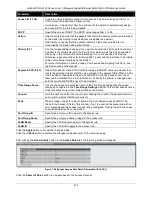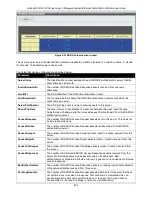
xStack® DGS-3120 Series Layer 3 Managed Gigabit Ethernet Switch Web UI Reference Guide
321
Authentication Process
Utilizing the three roles stated above, the 802.1X
protocol provides a stable and secure way of
authorizing and authenticating users attempting to
access the network. Only EAPOL traffic is allowed to
pass through the specified port before a successful
authentication is made. This port is “locked” until the
point when a Client with the correct username and
password (and MAC address if 802.1X is enabled by
MAC address) is granted access and therefore
successfully “unlocks” the port. Once unlocked, normal
traffic is allowed to pass through the port. The following
figure displays a more detailed explanation of how the
authentication process is completed between the three
roles stated above.
Figure 8-6 The 802.1X Authentication Process
The D-Link implementation of 802.1X allows network administrators to choose between two types of Access
Control used on the Switch, which are:
Port-based Access Control – This method requires only one user to be authenticated per port by a
remote RADIUS server to allow the remaining users on the same port access to the network.
Host-based Access Control – Using this method, the Switch will automatically learn up to a maximum
of 448 MAC addresses by port and set them in a list. Each MAC address must be authenticated by the
Switch using a remote RADIUS server before being allowed access to the Network.
Understanding 802.1X Port-based and Host-based Network Access Control
The original intent behind the development of 802.1X was to leverage the characteristics of point-to-point in LANs.
As any single LAN segment in such infrastructures has no more than two devices attached to it, one of which is a
Bridge Port. The Bridge Port detects events that indicate the attachment of an active device at the remote end of
the link, or an active device becoming inactive. These events can be used to control the authorization state of the
Port and initiate the process of authenticating the attached device if the Port is unauthorized. This is the Port-based
Network Access Control.
Port-based Network Access Control
Once the connected device has successfully been
authenticated, the Port then becomes Authorized,
and all subsequent traffic on the Port is not subject
to access control restriction until an event occurs
that causes the Port to become Unauthorized.
Hence, if the Port is actually connected to a shared
media LAN segment with more than one attached
device, successfully authenticating one of the
attached devices effectively provides access to the
LAN for all devices on the shared segment. Clearly,
the security offered in this situation is open to attack.
Figure 8-7 Example of Typical Port-based Configuration
Summary of Contents for xStack DGS-3120 Series
Page 1: ......
















































